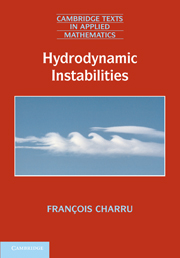Book contents
- Frontmatter
- Contents
- Foreword
- Preface
- Video resources
- 1 Introduction
- 2 Instabilities of fluids at rest
- 3 Stability of open flows: basic ideas
- 4 Inviscid instability of parallel flows
- 5 Viscous instability of parallel flows
- 6 Instabilities at low Reynolds number
- 7 Avalanches, ripples, and dunes
- 8 Nonlinear dynamics of systems with few degrees of freedom
- 9 Nonlinear dispersive waves
- 10 Nonlinear dynamics of dissipative systems
- 11 Dynamical systems and bifurcations
- Appendix A The Saint-Venant equations
- References
- Index
10 - Nonlinear dynamics of dissipative systems
Published online by Cambridge University Press: 05 August 2011
- Frontmatter
- Contents
- Foreword
- Preface
- Video resources
- 1 Introduction
- 2 Instabilities of fluids at rest
- 3 Stability of open flows: basic ideas
- 4 Inviscid instability of parallel flows
- 5 Viscous instability of parallel flows
- 6 Instabilities at low Reynolds number
- 7 Avalanches, ripples, and dunes
- 8 Nonlinear dynamics of systems with few degrees of freedom
- 9 Nonlinear dispersive waves
- 10 Nonlinear dynamics of dissipative systems
- 11 Dynamical systems and bifurcations
- Appendix A The Saint-Venant equations
- References
- Index
Summary
Introduction
As we have discussed in earlier chapters, a dissipative physical system in a uniform, stationary state can become linearly unstable when a control parameter R exceeds a critical value Rc. This occurs, for example, in the instability of a fluid layer heated from below governed by the Rayleigh number, or in the instability of plane Poiseuille flow governed by the Reynolds number. The instability can be manifested as the appearance of a stationary, spatially periodic structure (Rayleigh–Bénard convection rolls, for example), or as a growing traveling wave (Tollmien–Schlichting waves). This type of situation was studied in Chapter 8 for spatially confined systems, or systems with imposed periodicity, where the dynamics can be reduced to a system of differential equations for the amplitudes of a few spatial harmonics. When the physical system is spatially extended, that is, when its size is large compared to the wavelength of the periodic structure, the wave number spectrum tends to become continuous, and spatial modulations of the amplitudes can arise. The appropriate formalism for describing these modulations is that of envelope equations.
In the present chapter we shall present this formalism and study the conditions for saturation of the primary instability arising at R = Rc, as well as for secondary instabilities which arise when the bifurcation parameter exceeds a second threshold. First we study the case where the periodic structure is stationary, that is, where the eigenvalue of the linearized system crossing the imaginary axis at threshold R = Rc is real, i.e., the bifurcation is of the saddle–node or pitchfork type for a system possessing the reflection symmetry x → -x.
- Type
- Chapter
- Information
- Hydrodynamic Instabilities , pp. 299 - 325Publisher: Cambridge University PressPrint publication year: 2011



